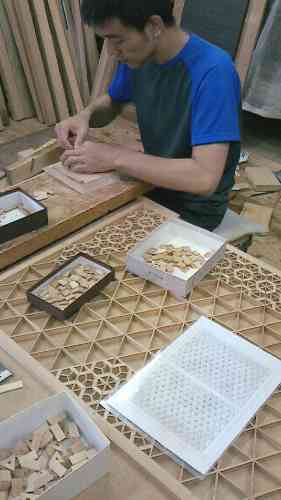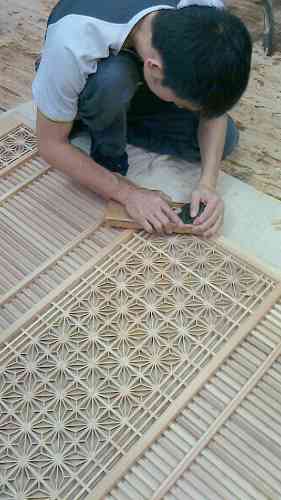Takahiro Tanaka
Edo Kumiko is an art consisting in cutting small wooden slats following specific sizes and angles, then to assemble them to create patterns. No nail is used during the assembly. The piece created will then be traditionally used to decorate a sliding door but our artisan, Takahiro Tanaka, innovates and creates objects like wooden screens and amps. He also embeds his artworks into furniture, such as tables for example, as decoration.
There are more than 200 patterns, created by imitating shapes existing in the nature.
The wood used is either cypress (hinoki), which has a light color, or Japanese cedar (sugi), which has a darker color.
Edo Kumiko was created at the end of the Heian era, in the 12th century. It was then used to decorate the sliding doors in the houses of the nobles. It was then used across the centuries in other objects, as lamps for example.
Matsuo Tanaka was born in the Niigata prefecture in 1943. Raised in a family of carpenters, he leaves at the age of 15 his family to go to Tokyo, where he becomes a disciple of an artisan making furniture. In 1982 he becomes independent and founds his own Edo Kumiko workshop.
Takahiro Tanaka, his son, was born in Tokyo in 1972. He studies engineering and architecture and graduates from university in 1994. After working 4 years as consultant, he joins his father.
This is his artworks that we propose you to discover.
His Edo Kumiko objects collection
Takahiro Tanaka

Edo Kumiko making steps :
The artisan starts by cutting the slats he will use for the assembly :

Then he plans the edges of the slats following specific angles to permit the slats to fit together in accordance with the selected pattern :

He can then assemble the slats to create the selected pattern :

He finally planes the surface of the assembly for the finishing :

There are more than 200 patterns, created by imitating shapes existing in the nature.
The wood used is either cypress (hinoki), which has a light color, or Japanese cedar (sugi), which has a darker color.
Edo Kumiko was created at the end of the Heian era, in the 12th century. It was then used to decorate the sliding doors in the houses of the nobles. It was then used across the centuries in other objects, as lamps for example.
Matsuo Tanaka was born in the Niigata prefecture in 1943. Raised in a family of carpenters, he leaves at the age of 15 his family to go to Tokyo, where he becomes a disciple of an artisan making furniture. In 1982 he becomes independent and founds his own Edo Kumiko workshop.
Takahiro Tanaka, his son, was born in Tokyo in 1972. He studies engineering and architecture and graduates from university in 1994. After working 4 years as consultant, he joins his father.
This is his artworks that we propose you to discover.
His Edo Kumiko objects collection
Takahiro Tanaka

Edo Kumiko making steps :
The artisan starts by cutting the slats he will use for the assembly :

Then he plans the edges of the slats following specific angles to permit the slats to fit together in accordance with the selected pattern :

He can then assemble the slats to create the selected pattern :

He finally planes the surface of the assembly for the finishing :

